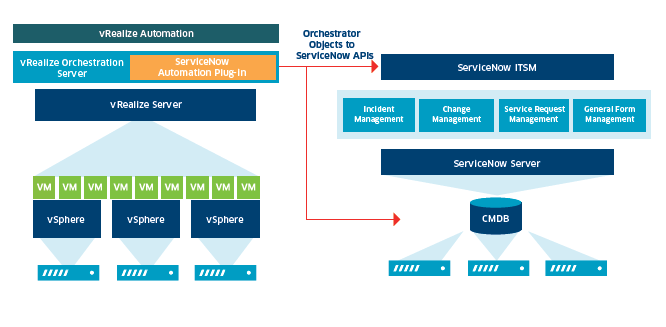ServiceNow is leading cloud based software platform, provides integrated suite of IT service management applications and helps modelling and automating many common organizations activities. ServiceNow has grown to serve the other major tasks of small to large enterprises like IT services desk, handle and resolve security breaches, HR service delivery, customer support & service and customized business applications.
VMware vRealize Automation (vRA) is an automation tool which automated the delivery of personalized infrastructure, application and custom IT solutions. vRA has self-service portal with wide range of features, allowing users to personalizing IT infrastructure, resource provisioning, configuration and automation of application delivery and containers management.
vRealize automation and ServiceNow, both are market leaders in their respective industry verticals. vRA is widely used in multivendor and multicloud support and ServiceNow created monopoly as an ITSM tools for any scales of organizations. With the growing need for agility and automation in businesses, IT needs to be facilitated by seamless integration of tools like vRA and ServiceNow. This integration allow enterprises to provide resources in agile and automated way through a centralized SERVICENOW portal along with the advantage of having catalog data maintained at single system that is SERVICENOW.
Plugins for Integrations
VMware ITSM Plugin for vRA
There are 2 options available to integrate vRA integration
- In first option, ServiceNow is used as a catalog(initiator for queries). Requests are raised at ServiceNow and vRA will be responsible for automation and orchestrations.
- In second option, vRA is used as catalog. vRA itself will be handling automation and orchestration along with focus on creating and updating CI records.
VMware has provided fully featured ‘VMware ITSM plugin for VRA’ for both of the above integration options. The plugin is free of cost and integration using this plugin may take weeks. But it is still recommended options as it has been provide in VMware repository. The features of the plugin allows us in
- Automating imports of catalog items and resources into ServiceNow application
- Automating resource provision updates into the ServiceNow CMDB and Self-Service portal
- Viewing and requesting AWS catalog items
- Performing Day 2 actions on provisioned resources from ServiceNow end.
Another advantage of ITSM plugin is that it can be used in both North/South and East/West type of integrations.
Customized Integration
There might be a specific and custom requirement for integration due to desired flexibility demand for some organizations. They can rather choose to go with creating a customized solution for vRA and ServiceNow integration. Efforts taken to develop solutions incur costs and time for organization but it is unavoidable.
Custom integration can be possible in 2 ways
- The first option is to use of vRA event broker update CI records during provisioning & de-provisioning and offload approvals to ServiceNow.
- Second option to use ServiceNow forms to make REST API calls to vRA catalog items. User can use custom business logic as a part of ServiceNow request.
Our Expertise
Calsoft was engaged with the customer for development of a ServiceNow Plugin to enable provisioning of vRA resources from the ServiceNow Platform. The engagement primarily involved:
- Import and request vRA Catalog Items from ServiceNow Service Catalogs
- Integrate with configuration management database (CMDB) and perform actions on the provisioned resources.
References
[Tweet “Integration of VMware vRealize Automation and ServiceNow ITSM Platform ~ via @CalsoftInc”]







